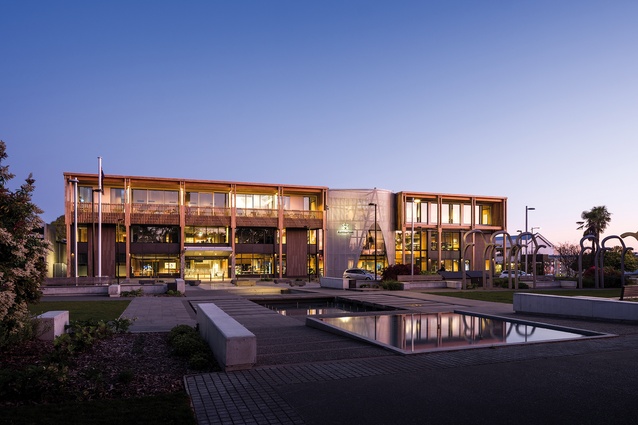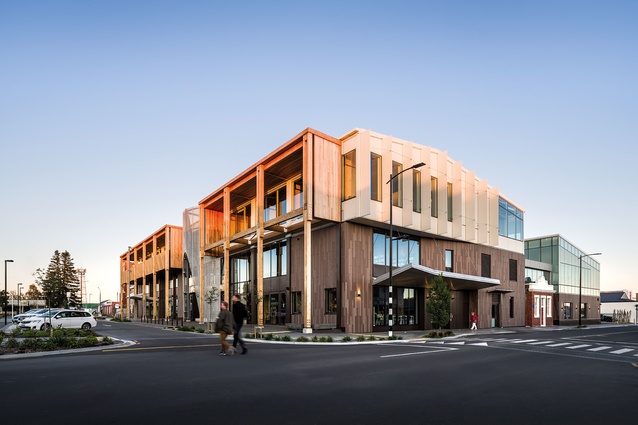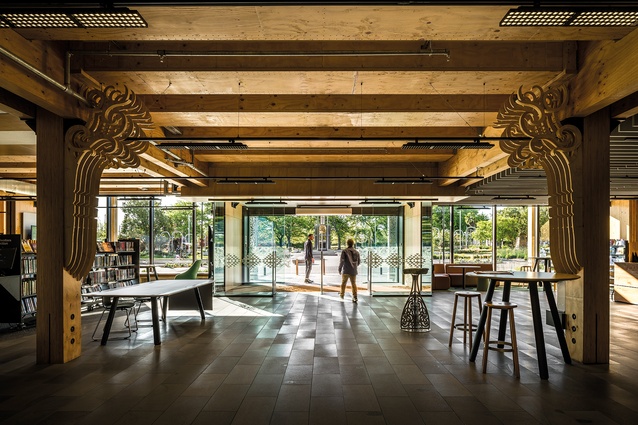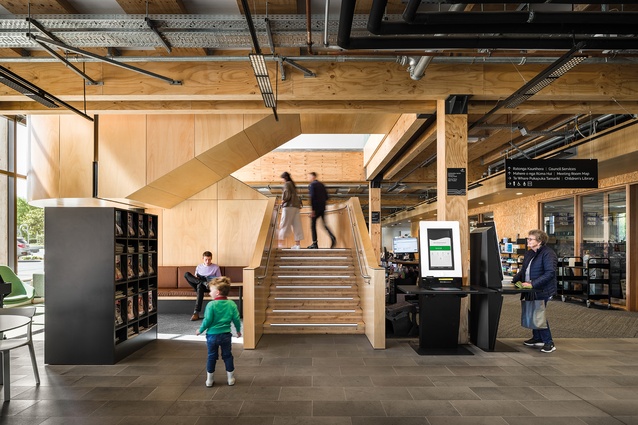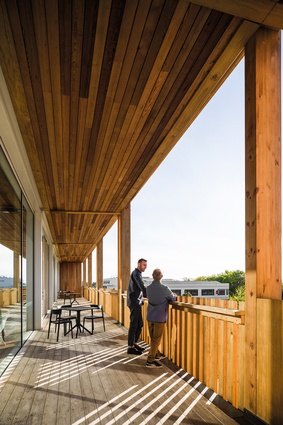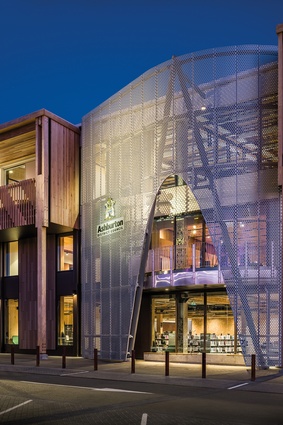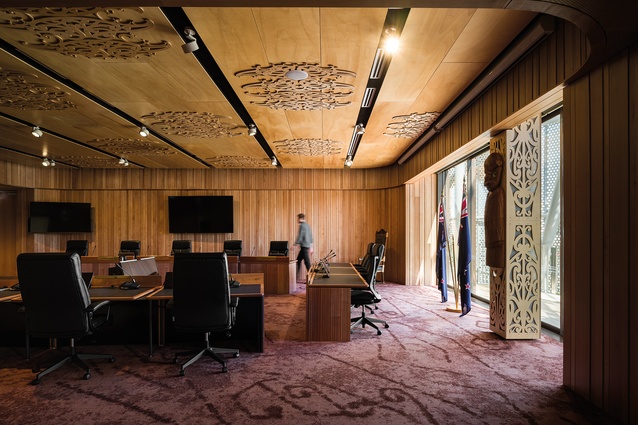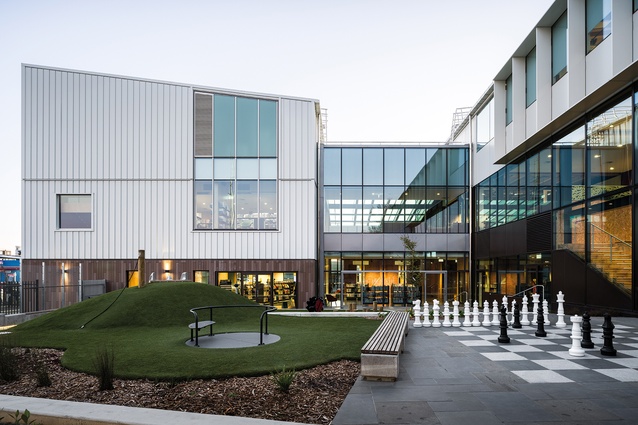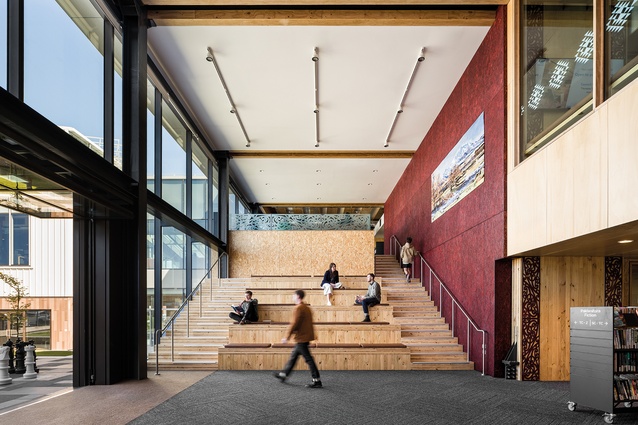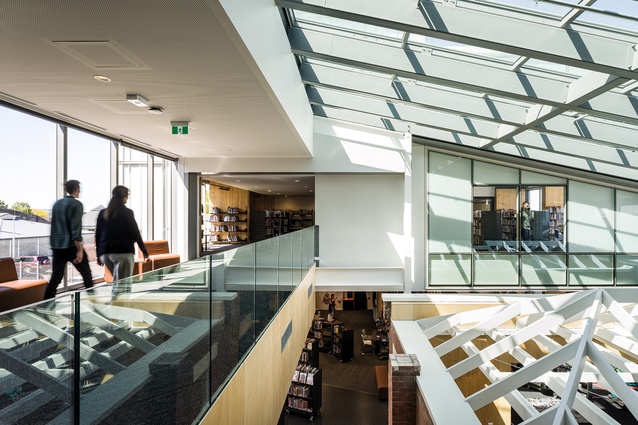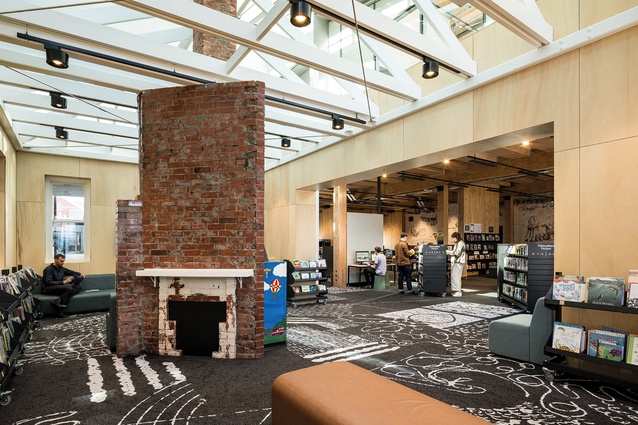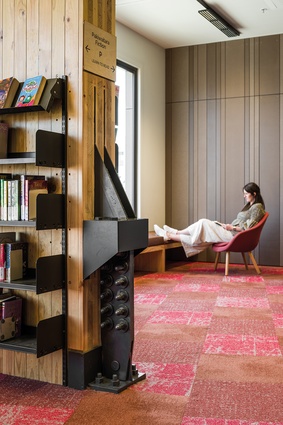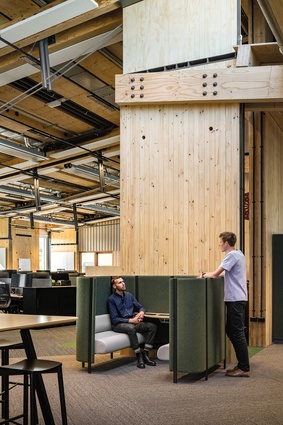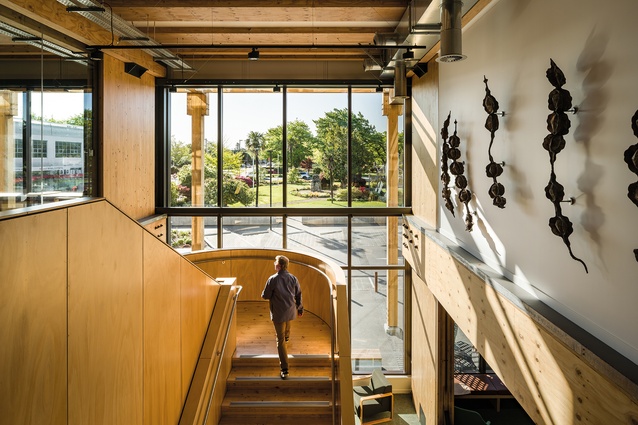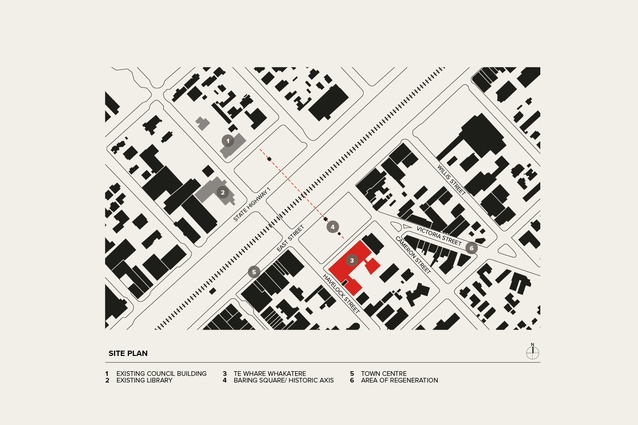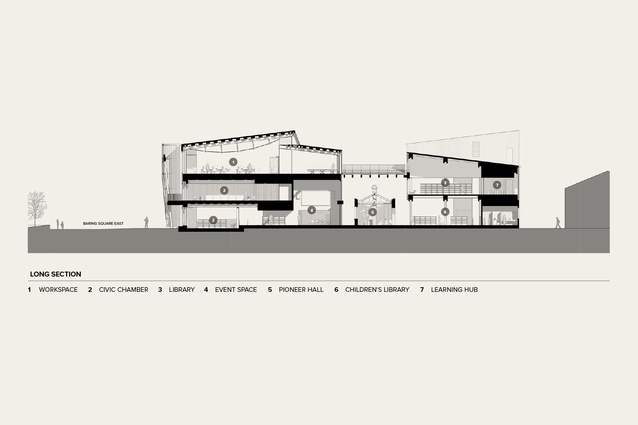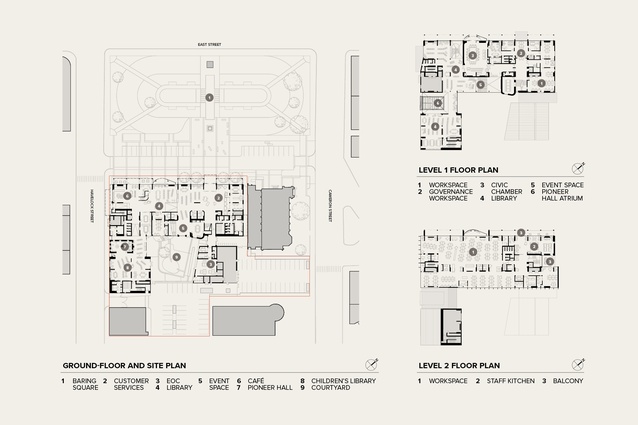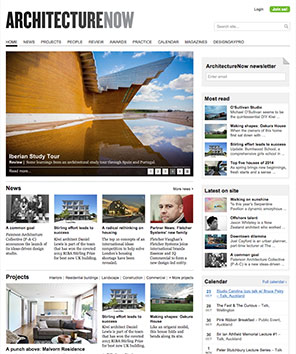The activator
Abigail Hurst explores the weaving together of the multifaceted Te Whare Whakatere, the Ashburton Library and Civic Centre, by Athfield Architects.
Gumboots, kids’ scooters and zimmer frames are not typically what comes to mind when thinking about the foyer of a local government office. Here at Te Whare Whakatere, Ashburton’s new Library and Civic Centre, this get-around gear is commonly sighted, and is testament to the facility’s accessibility to the diverse body of people that it serves.
Set beside the Ashburton River, on the east coast of the Cantabrian alluvial plains, Hakatere Ashburton is framed by fertile land and a strong agricultural history. This rural hub, just over an hour’s drive south-west of Christchurch, is becoming increasingly gentrified with families seeking an affordable country lifestyle with city amenities close by. Its current population of 21,300 is set to almost double by 2030. Baring Square, Ashburton’s historic centre, is named after the third baron of Ashburton, England, Francis Baring. State Highway 1 and the railway line bisect the town at this square, where the 1976 clock tower by Warren and Mahoney marks the County Council’s centennial. Te Whare Whakatere addresses this tower and the square, with frontages also to Havelock Street, adjacent to the pedestrian-oriented high street. The proposal to unite the previous council office and library services was made when both buildings were found to be unfit for purpose and earthquake prone. Strategically relocated to the more walkable eastern side, the project has sparked revitalisation, with new cafés and bars activating once-quiet blocks.
Impressions of feet mark Baring Square, re-landscaped alongside Te Whare Whakatere’s construction, stepping towards the main entrance as well as away to the Southern Alps. They signify a historic journey, one that local iwi Arowhenua would make from the sea to the mountains through to the west coast in the search for pounamu. Arowhenua worked with local artist and Ngāi Tahu master carver Fayne Robinson to continue the cultural narrative, with particular treatment to the street entrances with carvings and designs of local flora and fauna. The integration of these elements is significant for the country town, and emblematic of a more open dialogue beginning with manawhenua, echoed inside.
During consultation, the Council offered three options and was surprised when the public voted for the ‘big’ one. In response, more diverse functions and additional room for the projected population growth were added. A makers’ space, recording studio, café, event spaces and a learning lab, in addition to the library and civic facilities, made a unique combination that required sophisticated planning of security and circulation between private and public uses. Athfield Architects made several key moves to resolve this challenge. The three-storey timber structure is shaped in an ‘L’, forming a courtyard space. The emergency operations centre (EOC) for the district, also included in the brief, was seismically separated to meet IL4 (Importance Level 4) requirements cost-effectively.
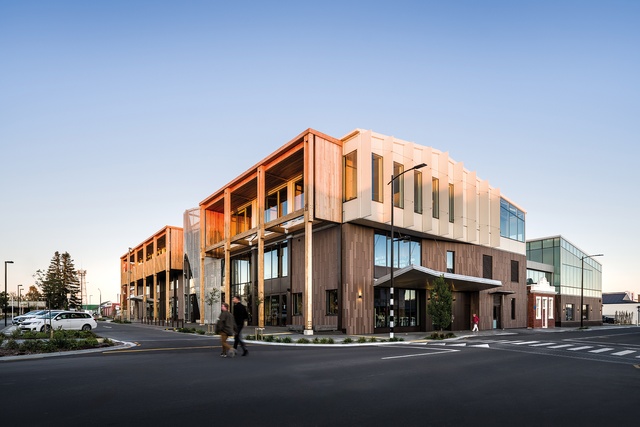
The ground floor is the ‘activator’: home to the primary public functions, with the café on the corner. Multiple entries provide pathways inside, circulation loops within the ground plane masterfully weaving spaces across the 1.5m floor-level drop. The exception is the children’s library (more on this later), with a single entry and exit for easy supervision, tucked into the end of the ground-floor arm. The Council’s office on the top floor takes advantage of the views, with a clerestory window letting additional light into the generous open-plan office. Here, members of the staff invited the adjustment from their previous closed-cell arrangements, enjoying increased levels of interaction within their teams.
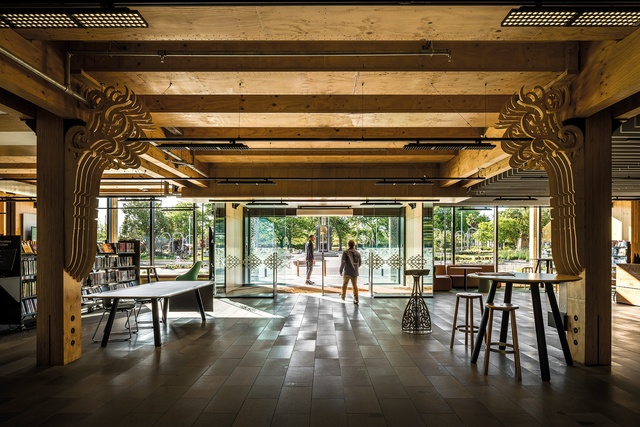
The civic chamber could have been placed on the top floor; however, it has deliberately been placed mid-level so that councillors descend from the office to the democratic space. In this position, the civic chamber maintains a balance of accessibility (visual and physical) and the privacy needed when the chamber is in action. Externally, a perforated, curved, stainless-steel screen makes it legible from the street, a playful reference to agricultural silos and also forming an ‘A’ for Ashburton. While distinct local features are woven throughout the building, this is a room with significant mana. Internally, the chamber has been dressed in rich native timber, with carvings by Robinson on the ceilings and columns. Custom broadloom carpets reference local mountains, waterways and fault lines, continuing the thread of cultural narrative from Baring Square. Used just 20 to 30 per cent of the year, the chamber was designed to interface with the library for future public events. The possibility of inviting the public into the heart of the building is a refreshing gesture — this council is willing to welcome its people.
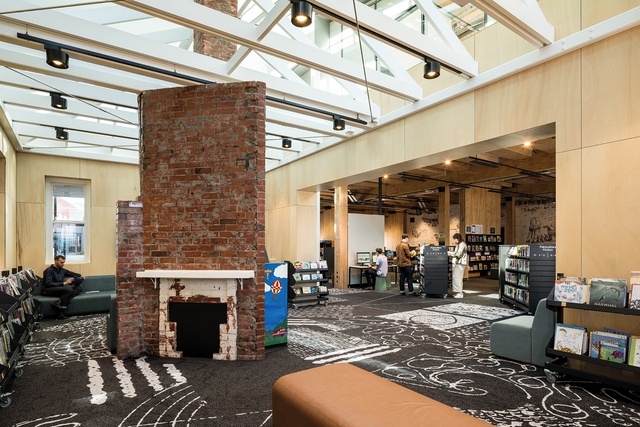
At over 6000m2 and three storeys, the building’s mass had the potential to overwhelm the settlement but careful treatment of the building’s façade, utilising timber posts to create a colonnade, softens its bulk. This is a gesture to its finer-grain streetscape and references the former County Building that once occupied the site. The stunning views — such as the vista of the Southern Alps — have been prioritised over energy-efficient, finely-tuned glazing. However, the colonnade facilitates a verandah, also acting as passive shading for the floor-to-ceiling windows. Cladding of earthy-red-toned, glass-reinforced concrete panels allude to the 100-year-old brick (recently strengthened) Methodist church bounding its northern side, and Pioneer Hall, housed within.
Pioneer Hall, situated within the site, was retained for its heritage value. A humble 1916 single-storey brick building, it was previously used for a variety of public functions, including Birthright (an organisation specialising in the support of single-parent whānau) and Ashburton’s first museum. It was something of a challenging obstacle to circulation until, finally, a delightful solution was come upon: to embrace the structure completely. Now, the hall is preserved, encased by the larger envelope around it. Even the crookedness of the chimney as it meets the fireplace has been kept: a quirk celebrated. The hall’s trusses are open to the first floor above, with sight lines in and through pleasing and creating rich interaction between spaces (such as paper plane competitions from the above bridge). The hall’s adapted purpose forms a memorable centre for the children’s library, its scale and warmth making small humans feel at home. A landscaped playground is adjacent, in the sheltered courtyard, catering further for littlies with a safe space for running wild and letting out pent-up energy.
The decision to use mass timber construction was also made after feedback from the public, and is a core component of the sustainability strategy, minimising the facility’s carbon footprint. Structural timber and services are largely exposed across the spaces, with innovative two- to three-metre-long cross-laminated timber (CLT) rocking walls utilised for gravity and lateral loads, and proprietary Potius plywood box beams used as the primary floor and ceilings. Artesian source heat pumping for heating and cooling has also been utilised to lower environmental impact, with all extracted water discharged back to the aquifer. Additionally, water is captured by the roof to be used for landscape irrigation, garden and a green wall which is part of the building’s footprint. Pipes and ducting are exposed as is most of the structure, alluding to Ashburton’s agricultural roots and showcasing the initiatives towards future resilience.
Constructed between 2021 and early 2024, the project faced pandemic delays, the consequential supply-chain shortage (at one stage, the custom steel bars needed for the CLT rocking walls were stuck on a ship on the Suez Canal) and material price increases (and the following inevitable value engineering). Throw in high winds that ripped off temporary protection and a couple of floods – the build weathered storms, literal and figurative. Its success is in the collective and brave vision of a diverse bunch of people – the Council as client with a truly collaborative approach – and its trust in the design team to lead them on the journey.
As we leave, a couple of farmers rock up in singlets and stubbies, the café is humming and families mill about the library. One can imagine hearing the click of knitting needles in the makers’ space and the Centennial county clock tower chime. Te Whare Whakatere is distinctly of its place, reflective of its people and open to its future. In a world questioning democracy, Ashburton’s civic heart is beating well. It has embraced its citizens, quirks and all.
Editor’s note: The correct photographer was not credited in the magazine version of this article. The photographer was Dennis Radermacher of Lightforge. Our sincere apologies for this error.

